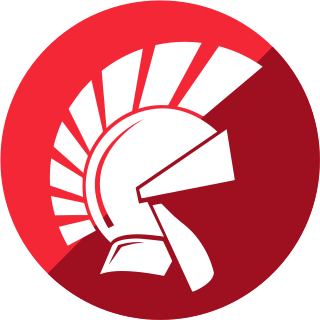A fourth-generation programming language (4GL) is any computer programming language that belongs to a class of languages envisioned as an advancement upon third-generation programming languages (3GL). Each of the programming language generations aims to provide a higher level of abstraction of the internal computer hardware details, making the language more programmer-friendly, powerful, and versatile. While the definition of 4GL has changed over time, it can be typified by operating more with large collections of information at once rather than focusing on just bits and bytes. Languages claimed to be 4GL may include support for database management, report generation, mathematical optimization, GUI development, or web development. Some researchers state that 4GLs are a subset of domain-specific languages.
HCL Notes and HCL Domino are the client and server, respectively, of a collaborative client-server software platform formerly sold by IBM, now by HCL Technologies.

Delphi is a general-purpose programming language and a software product that uses the Delphi dialect of the Object Pascal programming language and provides an integrated development environment (IDE) for rapid application development of desktop, mobile, web, and console software, currently developed and maintained by Embarcadero Technologies.

IBM CICS is a family of mixed-language application servers that provide online transaction management and connectivity for applications on IBM mainframe systems under z/OS and z/VSE.
Clarion is a commercial, proprietary, fourth-generation programming language (4GL), multi-paradigm, programming language and integrated development environment (IDE) from SoftVelocity used to program database applications. It is compatible with indexed sequential access method (ISAM), Structured Query Language (SQL), and ActiveX Data Objects (ADO) data access methods, reads and writes several flat file desktop database formats including ASCII, comma-separated values (CSV), DOS (binary), FoxPro, Clipper, dBase, and some relational databases via ODBC, Microsoft SQL Server, Sybase SQL Anywhere, and Oracle Database through the use of accelerated native database drivers, and XML, Clarion can be used to output to HTML, XML, plain text, and Portable Document Format (PDF), among others.
RPG is a high-level programming language for business applications, introduced in 1959 for the IBM 1401. It is most well known as the primary programming language of IBM's midrange computer product line, including the IBM i operating system. RPG has traditionally featured a number of distinctive concepts, such as the program cycle, and the column-oriented syntax. The most recent version is RPG IV, which includes a number of modernization features, including free-form syntax.
VisualAge is a family of computer integrated development environments from IBM, which supports multiple programming languages. VisualAge was first released in October 1993 and was discontinued April 30, 2007 and its web page removed in September 2011. VisualAge was also marketed as VisualAge Smalltalk, and in 2005, Instantiations, Inc. acquired the worldwide rights to this product. IBM has stated that XL C/C++ is the followup product to VisualAge.
CA Gen is a Computer Aided Software Engineering (CASE) application development environment marketed by CA Technologies. Gen was previously known as IEF, Composer by IEF, Composer, COOL:Gen, Advantage:Gen and AllFusion Gen.
EGL, originally developed by IBM and now available as the EDT open source project under the Eclipse Public License (EPL), is a programming technology designed to meet the challenges of modern, multi-platform application development by providing a common language and programming model across languages, frameworks, and runtime platforms.

Django is a free and open-source, Python-based web framework that follows the model–template–views (MTV) architectural pattern. It is maintained by the Django Software Foundation (DSF), an independent organization established in the US as a 501(c)(3) non-profit.
LINC is a fourth-generation programming language, used mostly on Unisys computer systems.

TELON, later renamed CA-TELON, is one of the first commercially successful application generators for building business applications.
Scaffolding, as used in computing, refers to one of two techniques: The first is a code generation technique related to database access in some model–view–controller frameworks; the second is a project generation technique supported by various tools.

Seaside, an acronym that stands for “Squeak Enterprise Aubergines Server with Integrated Development Environment,” is computer software, a web framework to develop web applications in the programming language Smalltalk. It is distributed as free and open-source software under an MIT License.
IBM App Connect Enterprise is IBM's premier integration software offering, allowing business information to flow between disparate applications across multiple hardware and software platforms. Rules can be applied to the data flowing through user-authored integrations to route and transform the information. The product can be used as an Enterprise Service Bus supplying a communication channel between applications and services in a service-oriented architecture.
CGIDEV2 is a free and open source IBM i based program development toolkit that facilitates the development of interactive web-based programs using RPG ILE or Cobol as the back-end Common Gateway Interface language. The functionality of this toolset is incorporated into an RPG ILE program by means of a service program that contains all of the procedures required to read input from a browser, generate and send the appropriate response back to the browser. CGIDEV2 is commonly used to generate static or interactive HTML/DHTML pages but it can also produce CSV, XML, Excel-XML and other text based files.
Embarcadero Technologies, Inc. is an American computer software company that develops, manufactures, licenses, and supports products and services related to software through several product divisions. It was founded in 1993, went public in 2000, and private in 2007, and became a division of Idera, Inc. in 2015.

WaveMaker is an enterprise grade Java low code platform for building software applications and platforms. WaveMaker Inc. is headquartered in Mountain View, California. For enterprises, WaveMaker is a low code platform that accelerates their app development and IT modernization efforts. For ISVs, it is a consumable low code component that can sit inside their product and offer customizations.



